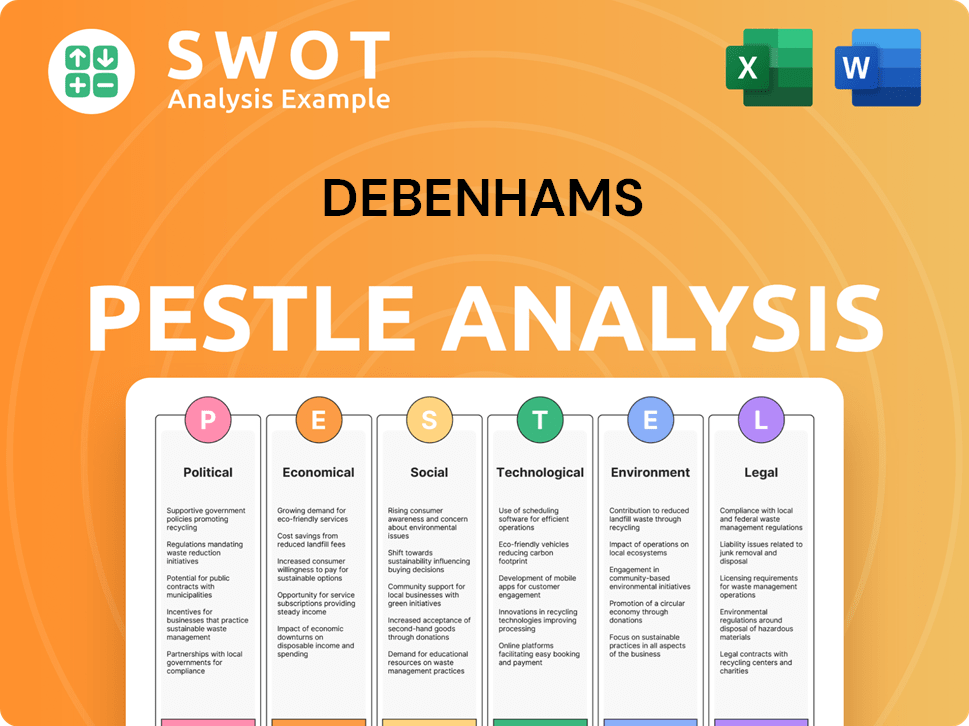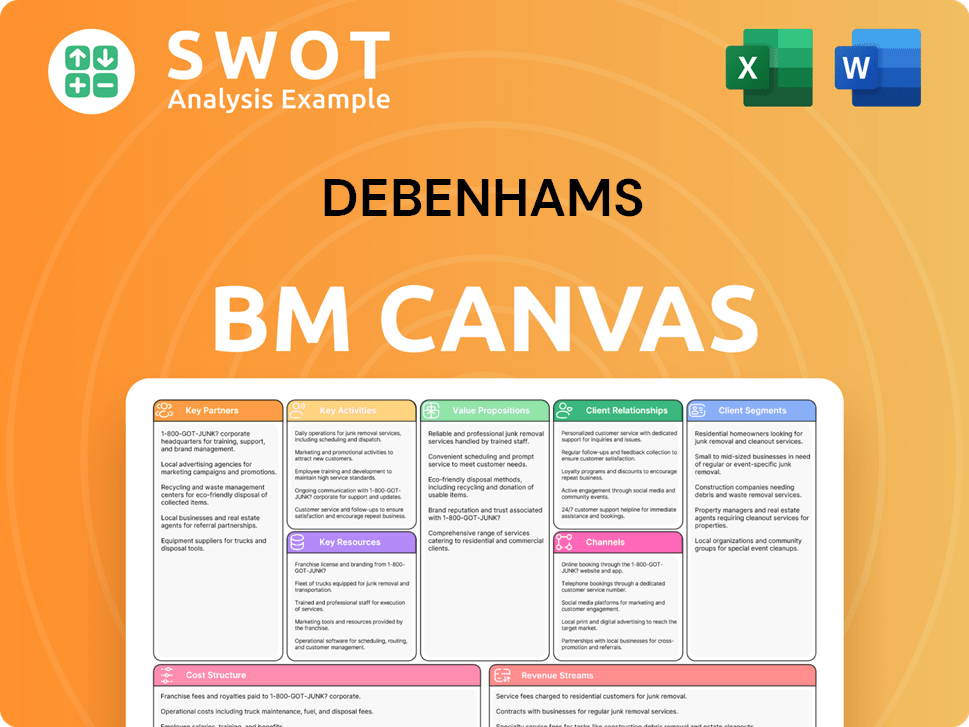Debenhams Bundle
Can You Believe Debenhams' Incredible Transformation?
Journey back to 1778 and discover the captivating Debenhams SWOT Analysis of a retail titan! From a single London draper's shop to a sprawling empire, the Debenhams company carved its place in British retail. Explore the history of Debenhams, a tale of ambition, expansion, and ultimately, a dramatic shift in the face of modern challenges.

The Debenhams history reveals a company that once dominated the high street with numerous Debenhams stores. This brief history of Debenhams department store highlights the founder's vision and the significant milestones that shaped its legacy. Understanding the Debenhams timeline is crucial to grasping its evolution and the factors that led to its current online presence.
What is the Debenhams Founding Story?
The Debenhams history begins in 1778, with the establishment of a draper's shop at 44 Wigmore Street in London. This marked the genesis of what would become a prominent retail entity. Initially, the business was known as Flint & Clark, setting the stage for the future.
The early focus was on luxury items, including expensive fabrics, bonnets, gloves, and parasols, catering to a clientele seeking quality and elegance. The year 1813 saw William Debenham joining as a partner, leading to the renaming of the company to Clark & Debenham, which signified a pivotal moment in its evolution. This partnership brought the Debenham family's involvement to the forefront.
The initial business model revolved around traditional drapery, offering a carefully selected range of high-quality goods. The merchandise included drapery, silks, haberdashery, millinery, hosiery, lace, and even family mourning goods. The economic environment of the late 18th and early 19th centuries, characterized by rising consumer demand for textiles and fashion, greatly influenced the company's creation and early success.
The early history of Debenhams is rooted in the late 18th century, evolving from a draper's shop to a department store giant.
- Founded in 1778 as Flint & Clark at 44 Wigmore Street, London.
- William Debenham became a partner in 1813, leading to the name change to Clark & Debenham.
- Focused on luxury items like fabrics, bonnets, and gloves.
- Operated as a traditional drapery, selling a variety of goods including silks and lace.
Debenhams SWOT Analysis
- Complete SWOT Breakdown
- Fully Customizable
- Editable in Excel & Word
- Professional Formatting
- Investor-Ready Format

What Drove the Early Growth of Debenhams?
Following its founding, the Debenhams company embarked on a period of substantial growth and expansion. This early phase saw the opening of new Debenhams stores and strategic shifts in business operations. These moves laid the groundwork for the company's future as a prominent retail entity.
By 1818, Debenhams opened its first store outside London in Cheltenham, mirroring the Wigmore Street establishment. Around 1843, another branch was launched in Harrogate. These expansions were supported by the issuance of a joint catalogue, 'The Fashion Book,' which facilitated a mail-order business.
In 1837, Clark retired, leading William Debenham to partner with William Pooley and John Smith, forming Debenham, Pooley & Smith. Later, Debenham brought his son, William, and Clement Freebody into the partnership, creating Debenham, Son & Freebody, and later Debenham & Freebody. This period marked significant changes in the Debenhams founder's business structure.
A key strategic move was the establishment of a wholesale business, supplying cloth and other items to dressmakers and large retailers. The business was incorporated as Debenhams Limited in 1905. This shift diversified the company's revenue streams and expanded its market reach.
The early 20th century saw rapid growth through acquisitions. Debenhams acquired Marshall & Snelgrove in 1919 and Harvey Nichols in 1920, maintaining their identities initially. By 1927, Debenhams had become the UK's largest department store retailer with 110 stores, highlighting its strategy of acquiring regional department stores. For more details, check out the Marketing Strategy of Debenhams.
Debenhams PESTLE Analysis
- Covers All 6 PESTLE Categories
- No Research Needed – Save Hours of Work
- Built by Experts, Trusted by Consultants
- Instant Download, Ready to Use
- 100% Editable, Fully Customizable

What are the key Milestones in Debenhams history?
The Debenhams history is marked by significant milestones that shaped its trajectory in the retail sector. From its early beginnings to its expansion and eventual challenges, the company experienced various phases of growth and transformation.
| Year | Milestone |
|---|---|
| 1950 | Became the UK's largest department store group, with 84 companies and 110 stores. |
| 1993 | Launched 'Designers at Debenhams', introducing exclusive merchandise through collaborations with well-known designers. |
| 1997 | Opened its first international franchise store in Bahrain, marking its global expansion. |
Throughout its history, the Debenhams company embraced several innovative strategies to stay competitive. These initiatives aimed to enhance the customer experience and expand market reach.
The introduction of exclusive merchandise through collaborations with renowned designers in 1993 was a significant innovation. This move helped differentiate the brand and attract a wider customer base.
Opening franchise stores internationally, starting with Bahrain in 1997, was a key step in expanding its global footprint. This strategy allowed the company to tap into new markets and increase its brand visibility.
Despite its successes, the History of Debenhams also includes periods of significant challenges. These challenges, including economic downturns and the rise of e-commerce, ultimately led to the company's decline.
The company faced intense competition from online retailers, which offered faster services and better user experiences. Economic uncertainties, including Brexit, also impacted consumer spending, affecting sales.
The company entered administration in April 2019 due to accumulated financial debts. The COVID-19 pandemic further worsened its situation, leading to a second administration in April 2020.
As a result of the administrations, the company closed all physical stores by May 2021. This led to the loss of up to 12,000 jobs, marking a significant impact on the retail workforce.
The decision to sell 23 properties in 2005 for nearly £0.5 billion, shifting focus from property management to retailing, is now viewed as a strategic misstep. This move contributed to the company's later struggles.
Debenhams Business Model Canvas
- Complete 9-Block Business Model Canvas
- Effortlessly Communicate Your Business Strategy
- Investor-Ready BMC Format
- 100% Editable and Customizable
- Clear and Structured Layout

What is the Timeline of Key Events for Debenhams?
The Debenhams company has a rich and complex history, marked by periods of significant growth and, more recently, substantial challenges. From its humble beginnings as a draper's shop in London to its evolution into a major department store chain, the Debenhams history reflects the changing landscape of British retail. Key events shaped the Debenhams timeline, from early expansions to acquisitions and ultimately, to its transition into a digital-first brand.
| Year | Key Event |
|---|---|
| 1778 | William Clark establishes a draper's store at 44 Wigmore Street, London, marking the beginning of the Debenhams founder's business. |
| 1813 | William Debenham becomes a partner, and the business is renamed Clark & Debenham. |
| 1818 | The first store outside London opens in Cheltenham, signifying early expansion. |
| 1905 | The business is incorporated as Debenhams Limited. |
| 1919 | Acquires Marshall & Snelgrove, extending its reach. |
| 1920 | Purchases Harvey Nichols, further expanding its portfolio. |
| 1928 | Debenhams is first listed on the London Stock Exchange. |
| 1950 | Becomes the UK's largest department store group with 84 companies and 110 Debenhams stores. |
| 1985 | Acquired by the Burton Group. |
| 1993 | Launches 'Designers at Debenhams,' a pivotal move in its brand strategy. |
| 1998 | Demerges from the Burton Group and relists on the London Stock Exchange. |
| 2003 | Taken private by a consortium. |
| 2006 | Relists on the London Stock Exchange. |
| April 2019 | Enters administration for the first time. |
| January 2021 | Boohoo Group acquires the Debenhams brand and website for £55 million. |
| May 2021 | All remaining Debenhams department stores close permanently in the UK. |
| September 2024 | Debenhams plans to launch international websites in Ireland and Australia. |
| March 2025 | Boohoo Group announces rebranding as Debenhams Group, with a focus on a marketplace model. |
Debenhams is undergoing a significant digital transformation, moving away from its traditional department store model. This shift is driven by the Boohoo Group's vision to establish a digital department store. The goal is to become a leading online retailer, aiming to be to retail what Spotify is to the music industry, focusing on a digital-first approach.
The new Debenhams Group is focused on a marketplace model. This strategy involves expanding its online presence and offering a wide range of products from various brands. The marketplace model is designed to enhance customer choice and drive sales volume. The goal is to achieve a £multi-billion Gross Merchandise Value (GMV) business in the medium term.
Debenhams is expanding its online presence internationally, with plans to launch websites in Ireland and Australia before the end of 2024. This move is part of a broader strategy to grow its customer base and revenue streams. The expansion will leverage the Debenhams brand recognition and trust in new markets, targeting a global audience.
The company aims to achieve approximately a 20% EBITDA margin on a net sales basis. Strategic initiatives include a new fulfillment service for brand partners and exploration of retail media. These initiatives aim to improve operational efficiency and enhance customer engagement. Debenhams is focused on building a leaner, faster, and technologically advanced global digital retail platform.
Debenhams Porter's Five Forces Analysis
- Covers All 5 Competitive Forces in Detail
- Structured for Consultants, Students, and Founders
- 100% Editable in Microsoft Word & Excel
- Instant Digital Download – Use Immediately
- Compatible with Mac & PC – Fully Unlocked

Related Blogs
- What is Competitive Landscape of Debenhams Company?
- What is Growth Strategy and Future Prospects of Debenhams Company?
- How Does Debenhams Company Work?
- What is Sales and Marketing Strategy of Debenhams Company?
- What is Brief History of Debenhams Company?
- Who Owns Debenhams Company?
- What is Customer Demographics and Target Market of Debenhams Company?
Disclaimer
All information, articles, and product details provided on this website are for general informational and educational purposes only. We do not claim any ownership over, nor do we intend to infringe upon, any trademarks, copyrights, logos, brand names, or other intellectual property mentioned or depicted on this site. Such intellectual property remains the property of its respective owners, and any references here are made solely for identification or informational purposes, without implying any affiliation, endorsement, or partnership.
We make no representations or warranties, express or implied, regarding the accuracy, completeness, or suitability of any content or products presented. Nothing on this website should be construed as legal, tax, investment, financial, medical, or other professional advice. In addition, no part of this site—including articles or product references—constitutes a solicitation, recommendation, endorsement, advertisement, or offer to buy or sell any securities, franchises, or other financial instruments, particularly in jurisdictions where such activity would be unlawful.
All content is of a general nature and may not address the specific circumstances of any individual or entity. It is not a substitute for professional advice or services. Any actions you take based on the information provided here are strictly at your own risk. You accept full responsibility for any decisions or outcomes arising from your use of this website and agree to release us from any liability in connection with your use of, or reliance upon, the content or products found herein.